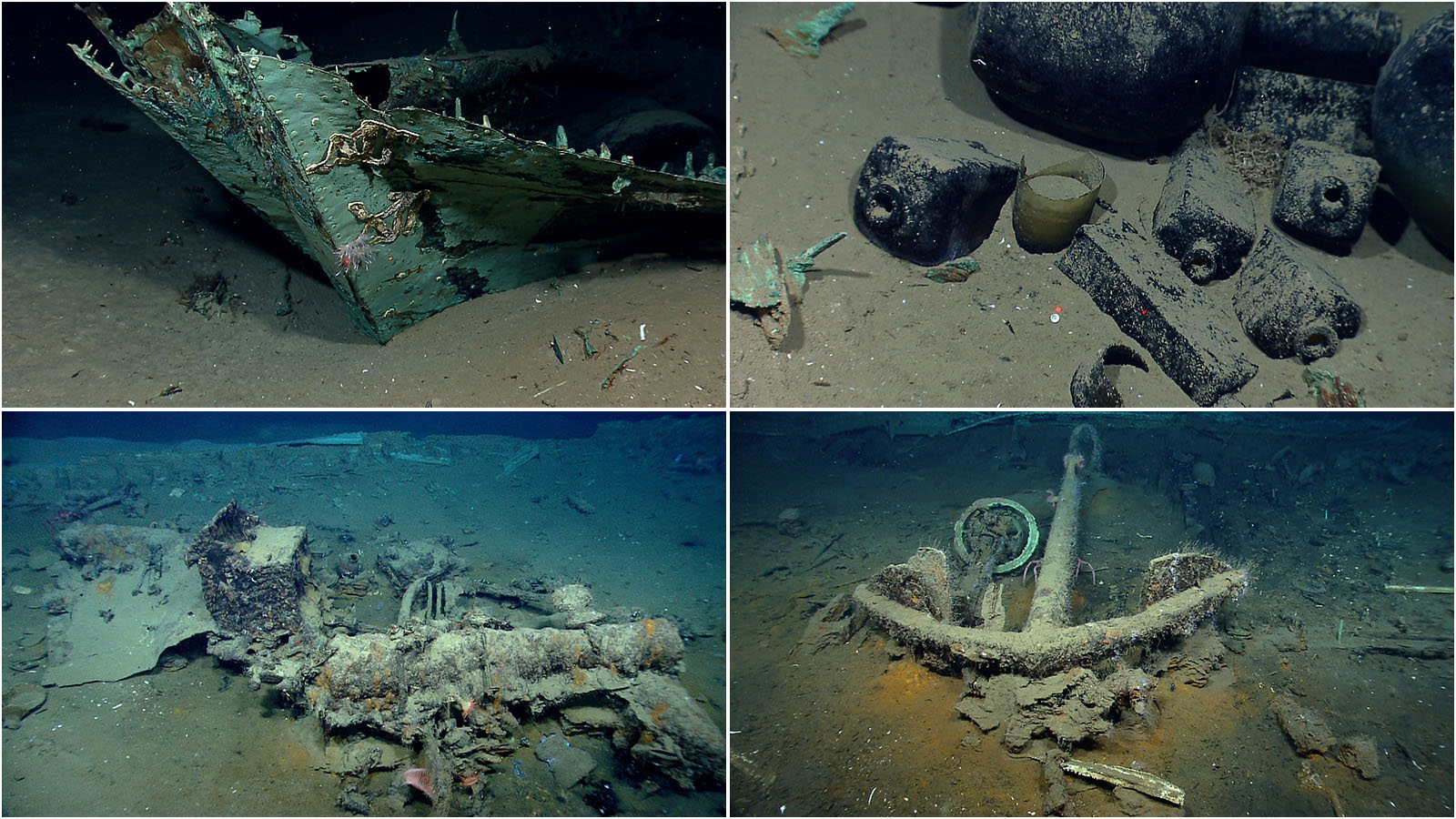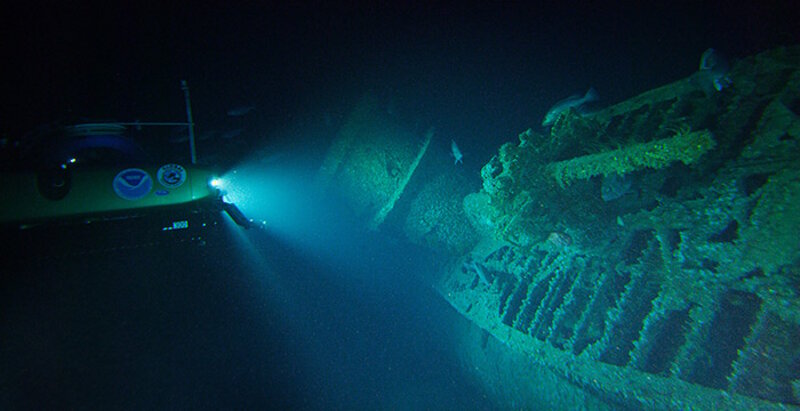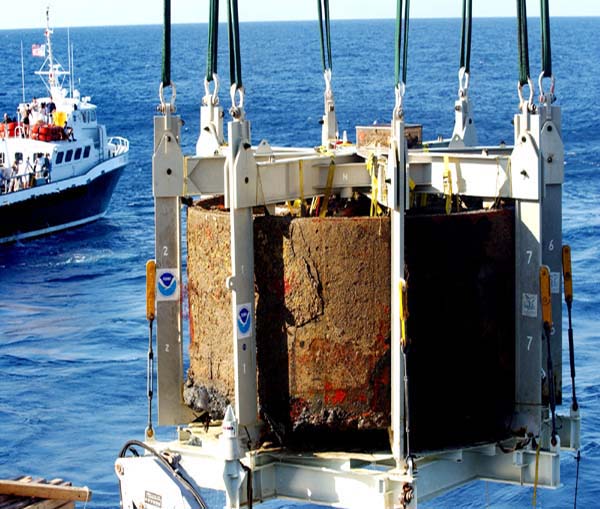NOAA Ocean Exploration works with partners from multiple sectors and across multiple disciplines to locate, identify, and protect important prehistorical, historical, cultural, and archaeological resources in our ocean and the Great Lakes. We also play a significant role in advancing the field by supporting the development, testing, and use of new technologies and methodologies that make this work possible.
To continue the celebration of 20 years of NOAA Ocean Exploration, here’s a look back at some of our maritime heritage highlights.
Historic Preservation: USS Monitor
Among the first efforts supported by NOAA Ocean Exploration was a series of expeditions in support of NOAA’s long-term plan to recover and preserve the Civil War ironclad USS Monitor, considered to be the U.S. Navy’s first modern warship. After the 1973 discovery of Monitor’s remains off the coast of Cape Hatteras, North Carolina, the wreck and the waters around it became America’s first national marine sanctuary in 1975. In 2001 and 2002, we partnered with the Navy, the Monitor National Marine Sanctuary, The Mariner’s Museum, and others for Preserving the USS Monitor 2001 and Monitor Expedition 2002. During these expeditions, we recovered Monitor’s steam engine, a significant portion of its hull, the gun turret and its two cannons, and hundreds of other artifacts.
World’s Most Famous Shipwreck: Titanic
First discovered in 1985, the resting place of RMS Titanic continues to capture our collective interest and has been the subject of numerous expeditions. In 2001, NOAA Ocean Exploration published guidelines for activities conducted at the site. Following these guidelines, we conducted two expeditions with partners, including partners from Canada and Russia: RMS Titanic Expedition 2003 and RMS Titanic 2004 Expedition. Activities included the use of human-occupied and remotely operated vehicles to assess the condition of Titanic after nearly 90 years underwater and microbial research to better understand the ship’s rapid deterioration. The 2004 expedition was featured in a National Geographic special “Return to Titanic,” which included live underwater video of the wreck taken from the remotely operated vehicle.
Nearly 20 years after the discovery of the remains of RMS Titanic, NOAA Ocean Exploration and partners revisited the site to study the ship's rapid deterioration. Video courtesy of the RMS Titanic Team Expedition 2004, ROI, IFE, NOAA Ocean Exploration.
Learn moreA Trio of Time Capsules: Monterrey Shipwrecks
In 2012 in the Gulf of Mexico, NOAA Ocean Exploration and partners conducted our first maritime heritage-focused remotely operated vehicle dives from NOAA Ship Okeanos Explorer. While exploring a site identified by the oil and gas industry, we discovered the remains of a wooden-hulled, copper-sheathed sailing ship and a variety of artifacts. Given the historical significance of the finding, NOAA Ocean Exploration supported returns to the site in 2013 with Exploration Vessel Nautilus and in 2014 with Okeanos Explorer. During the 2013 expedition, the team discovered two other shipwrecks. Researchers believe the three ships, now known as Monterrey A, B, and C, are related and that the first ship (A) was an early 19th century privateer or pirate ship and the other two were captured merchant ships, all most likely sunk together in a violent storm. They represent one of the more significant shipwreck sites discovered in the Gulf of Mexico and provide a glimpse into an important and turbulent time in American history.

Monterrey A rests beneath 1,330 meters (4,364 feet) of water in the Gulf of Mexico along with its cargo and other artifacts like a stove, cannon, and anchor as seen here. Images courtesy of NOAA Ocean Exploration, Gulf of Mexico 2012 and Exploration of the Gulf of Mexico 2014.
World War II Near U.S. Shores: German Submarine U-576 and SS Bluefields
As part of a comprehensive survey of World War II shipwrecks off North Carolina associated with the Battle of the Atlantic, in 2016 NOAA Ocean Exploration supported the NOAA Office of National Marine Sanctuaries in their exploration of the remains of a July 1942 merchant ship convoy battle. Among the expedition’s targets were the German submarine U-576 and the freighter SS Bluefields. During the battle, U-576 torpedoed Bluefields and was then sunk by another member of the convoy and U.S. Navy aircraft. Now they rest on the seabed, only a few hundred yards apart, where they were discovered in 2014 by NOAA archaeologists using sonar data previously collected by NOAA Ocean Exploration. The 2016 expedition used human-occupied and autonomous underwater vehicles to establish baselines for the condition of the wreck and document and highlight a little-known chapter in our maritime history. NOAA is considering expanding the Monitor National Marine Sanctuary’s boundaries to increase the protections to these and other historic shipwrecks.

During the first dive of the Battle of the Atlantic: Archaeology of an Underwater WWII Battlefield expedition, scientists explored the wreck of the German submarine U-576. In this image, the U-boat is seen lying on its starboard side with its conning tower and the deck gun. Image courtesy of John McCord, UNC Coastal Studies Institute.
Learn moreBeyond Shipwrecks: World War II B-29 Superfortress
Maritime heritage isn’t just about shipwrecks. In 2016, during the 2016 Deepwater Exploration of the Marianas, NOAA Ocean Exploration mappers detected sonar anomalies that suggested the presence of fragmented aircraft on the seafloor of the Saipan Channel off Tinian Island. Using remotely operated vehicle Deep Discoverer, we imaged one of the sites, which turned out to be the remains of a B-29 Superfortress. More than a dozen American B-29s were lost in the area while flying missions during World War II. This was the first one to be found. This discovery represents an important symbol of America’s final push to end the war and is of interest to management groups and others working to identify crash sites for the families of lost servicemen. NOAA Ocean Exploration is supporting another expedition to the area in 2022, which will be led by Scripps Institution of Oceanography.
More than a dozen American B-29s were lost in the waters around Tinian and Saipan in the Northern Mariana Islands during World War II. NOAA Ocean Exploration discovered the first of these aircrafts during the 2016 Deepwater Exploration of the Marianas. Video courtesy of NOAA Ocean Exploration, 2016 Deepwater Exploration of the Marianas.
Learn moreAlaska’s Underwater Battlefield: USS Abner Read
In July 2018, with support from NOAA Ocean Exploration, scientists from Scripps Institution of Oceanography and University of Delaware explored one of the most remote underwater battlefield sites of World War II. In the waters off Kiska Island, Alaska, the team discovered the missing 75-foot stern section of the U.S. Navy destroyer USS Abner Read, which broke away and sank along with 71 men when the ship struck a Japanese mine while on patrol. Other significant finds included three Japanese submarines, portions of a U.S. B-24 aircraft, and the remains of multiple Japanese and American landing craft. The results of this work will help shed light on the brutal and largely overlooked campaign in the Aleutians and, importantly, provide closure to the families of those who were lost.

The missing section of USS Abner Read’s stern was imaged using a remotely operated vehicle in 88 meters (290 feet) of water off Kiska Island, Alaska, in the Bering Sea. Image courtesy of Kiska: Alaska's Underwater Battlefield expedition.
Learn moreNot everything we find is what we think or hope it might be. Sometimes we’re pleasantly surprised by an unexpected discovery, and sometimes we’re a little disappointed. But, we always have a story to tell.
To learn more about NOAA Ocean Exploration-supported maritime heritage projects, visit our Expeditions by Topic web page and filter on “Marine Archaeology.”

